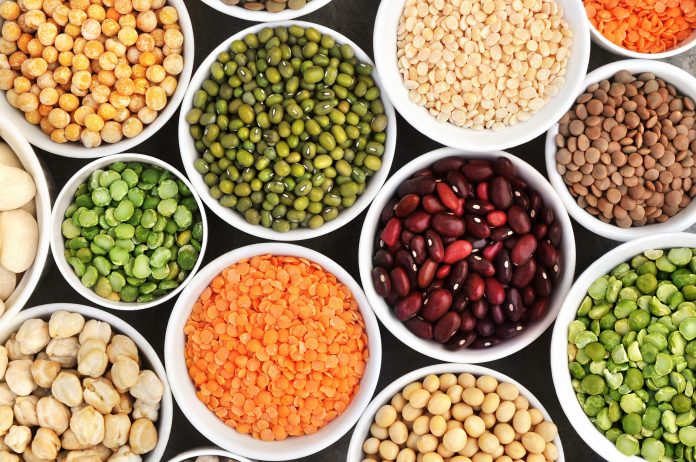Felix Dapare Dakora from Tshwane University of Technology, Pretoria, South Africa, discusses biological nitrogen fixation in legumes, including the opportunities for green agriculture and increased food security in Africa
The African continent is rich in legumes, which are unique in their ability to form root nodules with soil bacteria generally referred to as rhizobia. The root nodules are factories inside which the rhizobia reduce N2 gas in the atmosphere into ammonia using light energy from photosynthesis. Thus, nitrogen fixation in legumes is an environmentally-friendly green agriculture technology that has a low carbon footprint when compared to chemical fertilizers manufactured from fossil fuels using the Haber-Bosch process.
The ability of most legumes to form symbioses with soil rhizobia, fix atmospheric N2 gas, and synthesise nitrogenous compounds, makes food legumes, in particular, an excellent source of abundant high-quality dietary protein for human nutrition/health, and for use as feed and fodder for livestock. Other dietary features of grain legumes include low cholesterol, high fibre, high density of dietarily-important minerals, as well as abundant anti-oxidants such as flavonoids and anthocyanins, which, when consumed, can boost the human immune system and, thus, prevent or delay the incidence of cancer.
Biological nitrogen fixation in legumes, therefore, offers a myriad of opportunities that can be tapped for improving the quality of life in African communities, while advancing socioeconomic development. The inherently low nutrient soils in Africa pose a challenge to food/nutritional security as well as human health, especially where small-scale agriculture is most dominant. Due to the low levels of nutrients in grain crops grown on poor soils, approximately 232 million people suffer from trace element deficiency in Africa. Although the use of chemical fertilizers could overcome soil infertility and increase crop yields, the high cost of these fossil fuel-based fertilizers have prevented their use by resource-poor African farmers.
Additionally, chemical fertilizers such as nitrates cause environmental pollution. A cheaper and environmentally-friendly option has been the inclusion of nitrogen-fixing legumes in traditional cropping systems in Africa, supporting green agriculture. Studies done in my laboratory have shown that grain legumes can derive a substantial proportion of their N nutrition from biological nitrogen fixation (e.g. 50-97% by soybean, 24-67% by groundnut, 50-96% by cowpea, 40-75% by Kersting’s groundnut, 55-86% by mung bean, 27-92% by pigeonpea and 43-90% by Bambara groundnut). For farmers, that is a lot of saving from not using fertilizers on legumes, as many of them can obtain 50% or more of their nitrogen from the air and, therefore, do not require any external nitrogen fertilizers for a good yield. Through this process of nitrogen fixation, legumes can, therefore, sustainably spare native soil nitrogen for uptake and use by associated non-fixing, cereal crops. Where there is intercropping, an associated cereal crop can also benefit from the nodulated legumes via nitrogen excreted directly by plant roots and nodules.
Nitrogen contribution by legumes can vary depending on the efficacy of the bacterial symbionts nodulating the legume, as well as the legume species and/or genotype. For example, we have shown in my laboratory that the nitrogen contribution by grain legumes can range from 23 to 220 N.ha-1 for soybean, 46 to 188 kg.ha-1 for groundnut, 17 to 198 kg.ha-1 for cowpea, 42 to 400 kg.ha-1 for pigeonpea, 23 to 102 kg.ha-1 for Kerting’s groundnut, 31 to 111 kg.ha-1 for mung bean and from 6 to 200 kg.ha-1 for Bambara groundnut. The left-over legume residue, after grain harvest, is, therefore, very high in nitrogen and can serve as a source of high protein feed for livestock, as well as a rich source of nitrogen and other mineral nutrients for subsequent crops following decomposition in green agriculture.
In this case, the legume residue serves as a biofertilizer during crop rotation. We have shown in my laboratory that rhizobia that induce high levels of nitrogen fixation in legumes, also elicit greater uptake of mineral nutrients from the soil. Thus, high N2-fixing legume/rhizobia symbioses tend to accumulate more mineral nutrients in shoots than their less effective counterparts. This implies that high N2-fixers are a rich source of not only biological nitrogen but, also other mineral nutrients following residue decomposition and can, therefore, be used to improve soil fertility.
Nutritionally, the leaves and grain of high N2-fixing food legumes are usually very rich in protein which is synthesised from the accumulated fixed-N. For example, the leaf protein of 32 cowpea varieties was found to be 23-40% at Taung in South Africa and 28-40% at Wa in Ghana. Grain protein in the high N2-fixing landrace Bengpla was also 40%. As already indicated, high-fixing legumes generally elicit increased uptake and accumulation of minerals in organs, such as the leaves and grain of the host plant. This enrichment of mineral nutrients in edible parts of the legume can play an important role in human nutrition/health.
Our studies have shown that, with cowpea, the high N2-fixing varieties could accumulate 7.4-fold more Fe and 3.8-fold more Zn in edible leaves than their low-fixing counterparts. We also found that some cowpea varieties exhibited 34.2-, 34.0, 22.5-, and 18.3-fold higher Fe concentration in leaves than grain, and 3.5-, 2.0-, 2.0-, and 3.5-fold greater Zn in leaves than grain. Thus, the consumption of grain legumes, such as cowpea has the potential to eliminate protein-calorie malnutrition and trace element efficiency, which are highly prevalent in rural Africa. The ability of nodulated legumes to increase mineral uptake by roots is a function of the bacterial symbiont, and not the host plant. The rhizobial bacteria can produce organic acids that solubilise unavailable phosphorus for uptake by the legume; they can also produce siderophores that chelate with unavailable iron compounds for host plant uptake; and they are capable of producing indole acetic acid that promotes plant root proliferation and growth for increased uptake of water and nutrients.
Commercial bacterial inoculants formulated in Europe and North America and introduced into Africa are often less effective in nodulation and nitrogen fixation of food legumes in Africa due to prevailing factors such as high soil temperature, nutrient imbalance, drought during the cropping season and other soil properties, such as acidity. As a result, our approach has been to bioprospect for native rhizobia that are well-adapted to local African conditions and can fix lots of N under extreme environmental conditions such as low pH, high soil temperatures, drought events found in the continent. Those studies have involved the isolation of bacteria from root nodules and their characterisation using physiological, biochemical and molecular tools. Usually, bacterial genomic DNA is extracted and subjected to rep-PCR (BOX- PCR) using Box-A1R primer, followed by PCR amplification of 16S rRNA, protein-coding (atpD, glnII, gyrB and rpoB) and symbiotic (nifH and nodC) genes.
Ultimately, the gene sequences are compared with known sequences in the Genbank database for identification of the unknown bacterial isolates and for construction of phylogenetic trees to determine their relationships with known standard strains. In so doing, we discovered many novel isolates that have no relationship with any known standard rhizobial strains. Many of these novel isolates are waiting to be identified, while others that have been identified using phylogenies were found to be functionally superior in nitrogen fixation when compared to known commercial inoculant strains used by African farmers on cowpea and Kersting’s groundnut. For example, cowpea rhizobial isolates that were more effective than the commercial inoculant (Bradyrhizobium strain CB756) included TUTVUGH18, TUTVUSA41, TUTVUSA46 and TUTVUSA50. Of these, TUTVUSA41 was also found to have the ability to solubilize phosphorus and secrete abundant indole acetic acid for stimulating plant root proliferation and development.
With Kersting’s groundnut, the isolates that were significantly more effective than the commercial inoculant (Bradyrhizobium strain CB756) included TUTMGSA101, TUTMGSA116, TUTMGSA121, TUTMGSA126, TUTMGSA127, TUTMGSA140, TUTMGSA142, TUTMGSA148, TUTMGMZQ189, TUTMGMZQ190, TUTMGMZQ204, TUTMGMZQ205 and TUTMGMZQ206. We have, thus, isolated many indigenous African rhizobia with high N2-fixing ability and plant growth-promoting traits that can be used to make inoculants which are superior to the existing commercial inoculants used by farmers in Africa. Symbiotic rhizobia are, therefore, key to enhanced soil fertility, green agriculture, increased crop yields, and improved human nutrition/health in Africa.
Footnote
Acknowledgement: This work is supported with funds from the National Research Foundation of South Africa.
*Please note: This is a commercial profile











